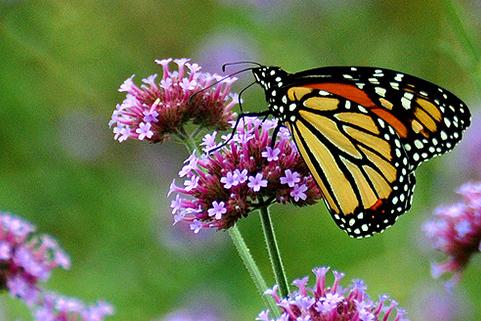
Study is the first to document a steeper rate of decline since 2008; also includes a detailed look at summer breeding numbers
The eastern monarch butterfly population—which has decreased for more than two decades—has declined at a steepening rate more than six times faster since 2008, according to a new study led by researchers at the University of Maryland (UMD) and the National Socio-Environmental Synthesis Center (SESYNC). This conclusion is based on a new analysis of population estimates from the butterflies’ winter habitat in Mexico.
The study, published in the August 5, 2015 issue of the Annals of the Entomological Society of America, raises concerns for the future of the highly charismatic monarch butterfly. In addition to the winter decline data, the paper also presents the most detailed look yet at summer breeding populations in the north-central United States, using data collected by citizen volunteers. Although no clear population decline was apparent in this summer data, the researchers observed several associations that could become clearer with more information, and thus might drive future research into the causes of monarch decline overall.
“Ours is the first analysis to show a steepening decline of monarchs, which is very worrisome,” said lead author Leslie Ries, now at Georgetown University, who performed the work while an assistant research biologist at UMD and a research fellow at SESYNC. “The findings also present a puzzle: why don’t we see the same declines in the summer breeding grounds? There is a hint of it, but no statistically significant evidence yet.”
Monarch butterflies are divided into two geographically distinct populations, separated by the Rocky Mountains. Every year, the eastern monarch population engages in one of the world’s longest and most complicated insect migration patterns. Adults spend the winter in a small mountainous region in southern Mexico, huddled in large bunches to conserve warmth. In the spring, they move north and spread throughout the eastern United States, where they breed throughout in the summer. After the new generation finishes metamorphosing from caterpillars to butterflies, the adults embark on the long return trip back to Mexico.
The relatively compact overwinter gathering sites offer the best opportunity to estimate the total size of the eastern monarch population every year. This yearly census has been underway since 1993 and has shown a steady average loss of 0.04 hectares of land area covered by butterflies per winter since about 1996. However, Ries and her colleagues are the first to note that the pace of decline has quickened since 2008. During that time, the rate of decline has risen to more than six times the previous rate, to an average of 0.27 hectares of butterfly-covered land area lost per winter.
“This is a huge concern. You need a very big migratory population because a lot of individuals are lost in transit,” Ries explained. “We don’t know how big the population has to be to make it, which means we might not have much time. I don’t think anyone expects monarchs to go extinct, but the large migratory population could be in serious trouble.”
It has been difficult to estimate monarch populations at other times of year, because the butterflies occupy a much larger geographic area as soon they leave their winter home. Monarchs return to the same breeding grounds in the summer, however, and two programs rely on citizen volunteers to count monarchs in these areas at the height of breeding season.
The North American Butterfly Association (NABA) and the Illinois Butterfly Monitoring Network (IBMN) have been conducting annual counts since 1992 and 1987, respectively. Although one previous study analyzed two breeding sites, Ries and her colleagues are the first to attempt a comprehensive analysis that includes most of the monarch’s primary breeding grounds.
This data did not reveal a statistically significant trend of decline, but Ries believes further study of summer population numbers will be important to help determine the main factors responsible for monarch declines.
“We don’t quite understand the underlying causes for monarch population decline. There are a lot of theories out there, and I imagine the truth will turn out to be a combination of factors,” Ries said. “We don’t want to put a lot of money toward conservation that isn’t effective. So it’s important to know what is going on, to make sure efforts are targeted appropriately.”
Ries points out that volunteer-based “citizen science” has an important role to play in the study of monarchs’ summer breeding grounds, because it would be impossible to survey such a widespread area using paid labor alone. Thankfully, it has been relatively easy to rally volunteers to the monarch’s cause.
“Monarchs are a species of concern that people see everywhere,” Ries said. “Most people will never see polar bears or wolves up close in the wild, but monarch encounters are common. Monarchs visit gardens, parks and backyards across the country. Kids can raise them in their bedrooms. People love monarchs and don’t want to see them decline.”
###
This work was supported by the National Science Foundation (Award No. DBI-11447049), the World Wildlife Fund, Telcel, and the Carlos Slim Foundation.
The research paper, “The Disconnect Between Summer and Winter Monarch Trends for the Eastern Migratory Population: Possible Links to Differing Drivers,” Leslie Ries, Douglas Taron, and Eduardo Salinas, was published August 5, 2015 in the Annals of the Entomological Society of America.
The National Socio-Environmental Synthesis Center, funded through an award to the University of Maryland from the National Science Foundation, is a research center dedicated to accelerating scientific discovery at the interface of human and ecological systems. Visit us online at www.sesync.org and follow us on Twitter @SESYNC.
Photo courtesy Oriol Gascón via Flickr/Creative Commons.
Press Contacts
Melissa Andreychek, SESYNC
mandreychek@sesync.org
(410) 919-4990
Matthew Wright, UMD
mewright@umd.edu
(301) 405-9267